- ARPDAUPosted 12 years ago
- What’s an impressive conversion rate? And other stats updatesPosted 12 years ago
- Your quick guide to metricsPosted 12 years ago
Indie Marketing: Tell the World! (part 3)
This article is a guest post by Ben Ward of Hogrocket, recapping a presentation given at the 2011 Develop Conference in Brighton. If you haven’t read the first or second parts of this article, please do check them out first!
In this final part of the indie marketing series I’ll be analysing some hands-on ways to get the word out about your game. The first two parts have been about analysing the existing marketplace and building your message, but this one concerns actually talking directly to the public.
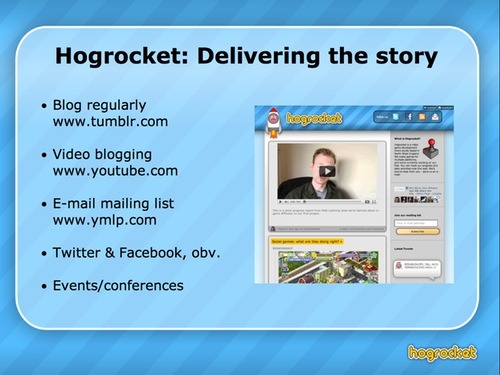
Promotional Blogging
The first tactic, and the one which will seem the most obvious, is blogging. BothPete and myself blog regularly, about a wide variety of topics including game design, business strategy, marketing, and more. We try to be as honest as possible with our blog posts, writing things that other authors sometimes tend to shy away from. We talk about money and how we are financed, the mistakes that we make, and also changes in our strategy as they evolve. Some teams think that changing their minds will brand them as inconsistent, but at Hogrocket we embrace the fact that we’re not always going to be right. We might as well talk about it!
We also have a Hogrocket company blog which not only has original content, but also “reblogs” some of Pete and my personal posts. We also try to get our content syndicated in a few different places to maximise the audience, such as AltDevBlogADay, GamesIndustry.biz, Gamasutra, etc.
We use a combination of Tumblr and WordPress to operate our blogs. Like most things at Hogrocket we opt for a managed approach rather than doing everything ourselves. When Tumblr writes the software THEY are the ones who provide a decent admin suite, keep their servers secure, guarantee uptime, and all of the other things that we shouldn’t need to care about. Pete and I just need to worry about providing good content, and we can let somebody else deal with the details of provisioning this to the masses. In fact if it were up to me I’d get Pete onto Tumblr as well, but he’s stubborn. 🙂
Promotional Video Blogging
Something we are trying to do more of is video blogging. We’ve filmed a couple of short videos on Youtube, but the original plan was to have much more video content by now. The reason for this emphasis is because video goes a long way to reinforce the aim of being honest and transparent. It’s a bit embarrassing and low-budget, but people are more likely to absorb the content and understand your message if you tell them verbally, using video to get across your attitude and body language. Text can be (and frequently is) misinterpreted, but this doesn’t happen nearly as often with video.
Our videos were filmed using a Panasonic Lumix G10 DSLR camera on a tripod. This camera was relatively cheap to buy, and provides a decent picture quality for the low cost. The videos were edited in iMovie on a Mac, and then uploaded to YouTube. We selected YouTube rather than Vimeo because it has a greater footfall, although either service would work. In fact, it might be worth using both.
Marketing Mailing List
We use mailing list software to keep a list of our contacts and associates (like a massive address book), and also to send out e-mails in bulk. At Hogrocket we try to post exclusive content to the mailing list that we don’t mirror anywhere else; we figure that if somebody has signed up to receive our spam then they at least deserve something a little special! Rewarding your most dedicated fans is good practice, and sending personal and interesting e-mails fits the bill.
While it’s possible to maintain a mailing list yourself (either in a spreadsheet or using bespoke software), it’s harder to send out e-mail in bulk to thousands of people. Many ISPs have limits for the number of mails you can send in a day, not to mention how efficient services like Gmail have become in filtering spam. Also if you do everything manually (like I’ve done in the past) you also get the headache of manually removing mails that have bounced, and manually searching for duplicates. This doesn’t sound too bad until you get about 200 of them all come through in dribs and drabs many weeks after you sent the initial e-mail!
So I’m an advocate of using specialist software to handle all of this for us. We use a site called YourMailingListProvider, which is a decent, feature-rich website which won’t break the bank. You can add a whole bunch of people to lists, and split them up according to groups which you define. For example, we have separate groups for games press and games industry, so that we can target each subset individually if we want to. YMLP also provides a service for website forms, so we are able to provide a sign-up box on our website which hooks up directly to our mailing list. The site also automatically removes bounced e-mails from your lists, and automatically deals with duplicates. You pay per user per newsletter sent out, and all of your old newsletters are hosted on the YMLP servers for public reference. All in all a great service, and one that’s worth the cost in my opinion.
Twitter & Facebook
Obviously you should be using Twitter and Facebook. There are millions of tutorials all over the Internet on how to do this effectively, so I won’t repeat it here.
Events/conferences
Going to various specialist events and industry conferences can be a fantastic way to meet new people and forge new business relationships, and it’s also nice to get out of the office for a few days. However, they can be expensive to attend; both in terms of money and lost time. At Hogrocket we’re not great at attending conferences, mainly due to the fact that we’ve been so heads down on Tiny Invaders over the past few months. We’re hoping to improve in this area in the future though.
One thing that’s worth pointing out is this: it also makes sense to attend conferences outside of the games industry. Of course we should all try and get to GDC, Gamescom, Develop, etc., but in my mind a smart developer also has his eye on the bigger picture. Our universe has expanded massively over the past few years, and games developers are seeing interest from not only the likes of Hollywood, but from all sides. Attending conferences for the music industry, the publishing world, or even further afield can only help us as our work becomes more accepted worldwide.
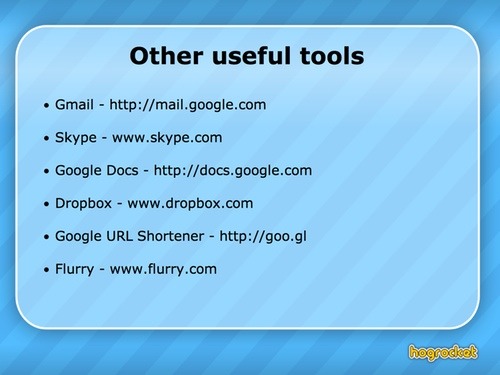
There are other tools which no self-publishing game developer should be without.
- Google Mail/Calendar – in my opinion this is the best online productivity suite. If you’re not using it already then you should be. Gmail’s features for filtering/sorting/searching e-mail are excellent; this is essential when you consider the amount of mail you’ll be sending when self-promoting. By the way – don’t delete any e-mails, ever! Use Gmails archive function to move it out of your inbox, but don’t delete! You never know when you’ll need to refer back to conversations, even if it’s just to dig up the mail from some guy who didn’t seem important at the time.
- Skype – needless to say Skype is great for meetings between your team, but it’s also a good tool to help you spread the word on a 1-to-1 basis. Use Skype to meet with important clients and leading community figures, and try to use video chat when possible. Face-to-face communication is always best. See my blog post on remote working, titled “The First Mistake”, for more information.
- Google Docs – obviously this is useful for collaboration between team members – being able to remotely edit the same document at the same time (and see each other’s changes!) is pretty cool. However, we also use Google Docs to share some documents publicly with the word. For example, we published our company announcement press release using the service.
- Dropbox – Again, Dropbox is great for inter-team collaboration. It’s also great for sharing assets/documents/whatever publicly using the built-in “Public” folder. Whereas Google Docs is great for documentation, Dropbox is better suited for larger static files like trailers or demos.
- Google URL Shortener – It’s often useful to shorten your large URLs into snippets, especially in the Twitter universe. There are many companies which provide this service; my favourite is goo.gl. It’s really easy to shorten a URL (it takes about 2 seconds), and after that you can track some pretty decent statistics about the usage of your redirect. We use this for App Store links, mailing list links, and important things on Twitter. The only beef you might have with goo.gl is that the generated stats are publicly accessible, so if you don’t like the idea of that then feel free to use one of the hundreds of competitors instead.
- Flurry – This is mainly a development tool used to gain insight into how people play your game. However, with the combination of developer and publisher duties it makes sense to build marketing-related analytics in right from the start.
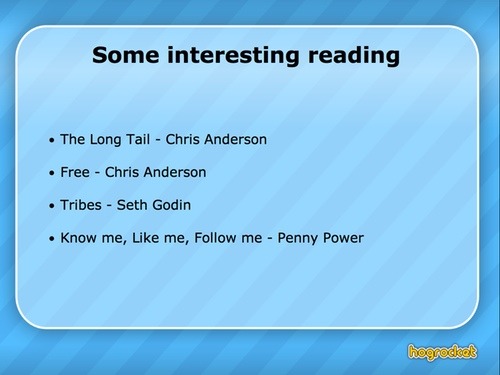
Here are some great books which provide a much greater insight into some of these topics than I could hope to cover in a single blog post. Check ‘em out.
- The Long Tail, Chris Anderson
- Free, Chris Anderson
- Tribes, Seth Godin
- Know me, Like me, Follow me, Penny Power
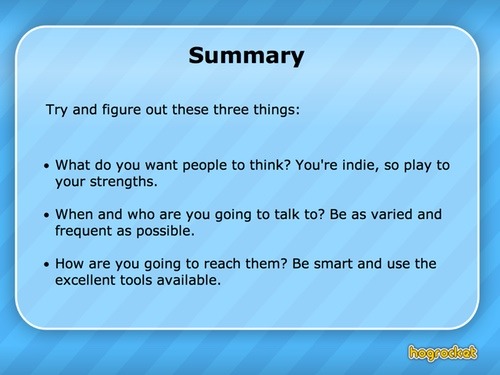
Summarising an entire presentation (which you’ve read in the three quite varied blog posts) was a difficult slide to write! I chose to pick three things that you should remember if you decide to embark on the self-publishing quest yourself.
Firstly, think about your message. What do you want people to think about when they hear your company name? For Hogrocket we’ve chosen “what’s it like to start an indie games studio?”. Yours will be different, but just make sure you play to your strengths as an indie. You can do things that the big studios can’t, i.e. talk honestly with your customer base, change strategy at the drop of a hat, etc. Choose your message and play to your strengths.
Think about your schedule. Who are you going to talk to, and when are you going to talk to them? If targeting press, which ones should get a personal e-mail? Which ones should get a promo code? Which should be added to the mailing list? If talking to the public, how (and when) do you accomplish this? If you’re using Twitter be mindful that you’ll only be talking to people in your limited social sphere, and in your current timezone. Can you find a way of talking to everybody in all timezones, all the time? Generally our approach to scheduling our messaging is to “always make time to talk about the studio, but only talk about the games when people can buy them”.
Finally, think about how you’re going to reach these people. Which tools will you use? We use the Internet every single day in a variety of ways in order to reach a wide span of audiences. There are hundreds of fantastic tools available, some of which I’ve listed above, which can save you time, money, and energy. If you’re a programmer remember that you don’t have to write absolutely everything yourself.
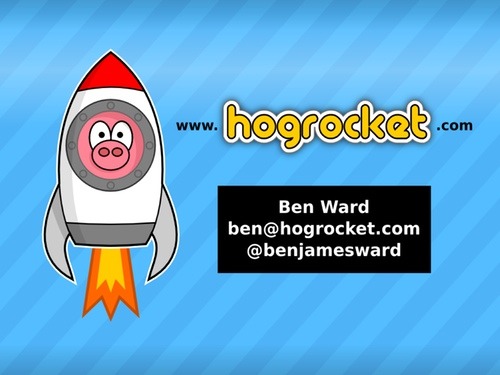
Thanks very much for making it to the end of this three part series. If you’d like to read more about Hogrocket please check out our website athttp://www.hogrocket.com. You can also visit my personal blog athttp://benjamesward.tumblr.com. Finally, please do take a look at our first game release! It’s called Tiny Invaders, and you can download it from the iOS App Store here: http://itunes.com/apps/tinyinvaders
Thanks again!
Ben Ward
Co-Founder
Hogrocket











